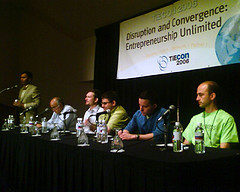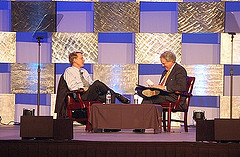The SVASE VC Breakfast Club session I’ll be moderating on Thursday, May 25th in San Francisco will be somewhat exceptional: this will be the first time pitching entrepreneurs get to know the VC closely prior to the event. That’s because Will Price, Principal at Hummer Winblad Venture Partners is an active blogger himself. His recent post Questions to Ask is a must-read – but I really don’t want to pick one post only: if you plan to attend the session, do yourself a favor and check out his blog (and if you don’t come to our breakfast, it’s still worth reading)
That said, my standard pitch: The VC Breakfast is an informal round-table where up to 10 Entrepreneurs get to deliver a pitch, then answer questions and get critiqued by a VC Partner. We’ve had VC’s from Draper Fisher, Hummer Winblad, Kleiner Perkins, Mayfield, Norwest, Trinity, Mohr Davidow, Emergence Capital …etc.
These sessions are an incredible opportunity for Entrepreneurs, most of whom would probably have a hard time getting through the door to a VC Partners. Since I’ve been through quite a few of these sessions, both as Entrepreneur and Moderator, let me share a few thoughts:
- It’s a pressure-free environment, with no Powerpoint presentations, Business Plans…etc, just casual conversation – but it does not mean you should come unprepared!
- Bring an Executive Summary – some VC’s like it, others don’t.
- Follow a structure, don’t just talk freely about what you would like to do, or even worse, spend all your time describing the problem, without addressing what your solution is.
- Don’t forget “small things” like the Team, Product, Market..etc.
- It would not hurt to mention how much you are looking for, and how you would use the funds…
- Write down and practice your pitch, be ready to deliver a compelling story in 5 minutes. You may have more time, but believe me, whatever your practice time was, when you are on the spot, you will likely take twice as long to deliver your story.
- Last, but not least, please be on time! I am not kidding… some of you know why I have to even bring this up. As a matter of fact, our host, Deloitte & Touche specifically asked participants to allocate an extra 5 minutes to get through building security.
For event details check the Zvents post and remember to click through to register – there are only 10 slots and this one will sell out early!
Tags: Venture Capital, VC Breakfast, Funding, VC Funding, Startups, Entrepreneurship, SVASE, WillPrice, HummerWinblad, zoliblog


 Liveblogging
Liveblogging  Raw notes from the discussion with
Raw notes from the discussion with  New subject: Technology – what’s coming next? John Doerr: Biology. This is what he really wants to talk about, now he gets passionate. He talks about soon-to-debut “
New subject: Technology – what’s coming next? John Doerr: Biology. This is what he really wants to talk about, now he gets passionate. He talks about soon-to-debut “

Recent Comments